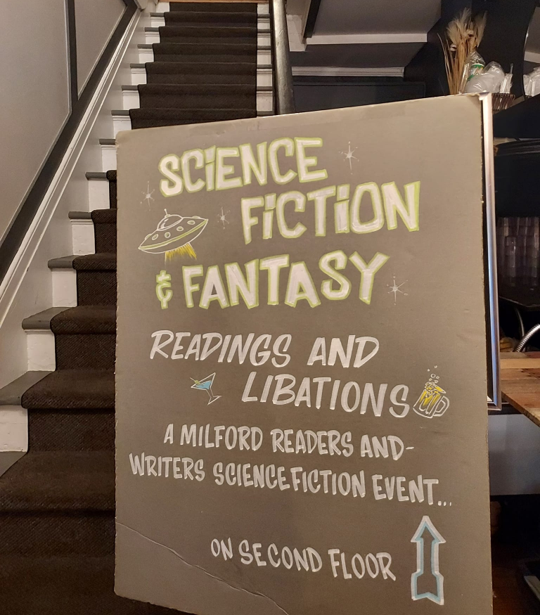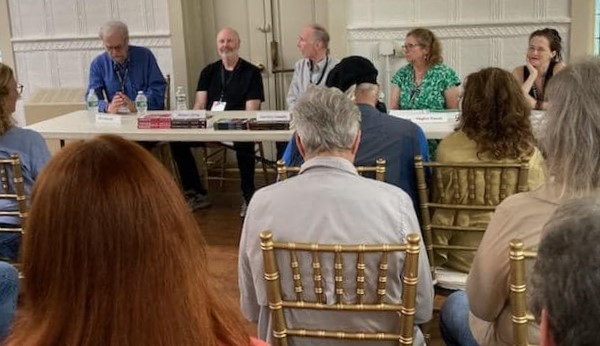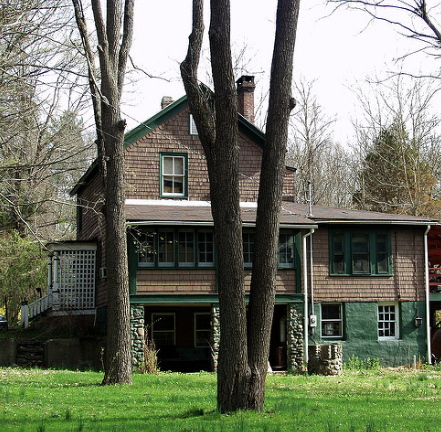
In an age when professional magazines are inundated with computer-generated submissions and screen actors can be replaced by CG doppelgangers, there are still activities that remain exclusively in the human domain.
I’m referring to in-person events. You can try and simulate them with Zoom and Facetime, but there’s nothing like the real thing, and I saw proof of that yet again while taking part in a series of panels, book signings, and readings at this year’s Milford Readers & Writers Festival.
I covered portions of the festival in the previous posts Forward into the Past and Authors, The Anchorage, and Arrowhead.
The following covers a few more highlights from the weekend.
tales of ghosts and arcane designs

In my previous post, I shared some of the history discussed during our panel on Milford and science fiction. But some equally interesting stories dealt with ghosts, strange occurrences, and cryptic graffiti.
Consider, for example, Michael Libling’s recollection of his first visit with agent Virginia Kidd at her Milford home, a centuries-old structure known as Arrowhead.

It was like approaching a haunted house. It really was, I mean, I crossed the porch and entered the house, and I guess it was Vaughne who ushered us in.
Virginia was bedridden by that time, and my wife, the kids, and I sat around and chatted with Virginia. Then we went out for dinner, and I came back alone to sit and talk till the wee hours of the morning. And the thing that really got me was, here’s this bedridden woman in the house alone, and she never locks the doors.
I asked her about that. Wasn’t she worried?
And she said, “No. The spirits are here to protect me.”
Of course, that was then. “These days,” as Christine Cohen pointed out, “all of Arrowhead’s doors are locked,” with the current residents depending “on both ghosts AND Kwikset deadbolts” to keep the place secure.
In addition, Michael’s mention of the Arrowhead spirits conjured a ghostly tale from Vaughne Hansen, who told about a writer’s ghost (a ghostwriter?) who apparently liked using one of the Arrowhead typewriters.
Vaughne would turn the machine off at the end of the day, then return in the morning to find it running. “Then one day when I was leaving the house, I said, ‘Please turn the typewriter off when you’re finished with it.’ After that, it never happened again.”
And then there was Christine Cohen’s account of a cryptic diagram, a portion of which can still be found inside an Arrowhead medicine cabinet.

Here’s the story Christine told about the drawing:
It’s actually a transistor radio drawn by Virginia’s son Benjamin. And once he finished it, somebody went into the bathroom and drew a line from the medicine cabinet out onto the wall, and then someone added something to make it a time-travel machine, and then somebody came in after and added something to make it a pathway to Milford and Arrowhead. And it just kept going until the whole room was covered with drawings by famous and no-so-famous writers and visitors.
It was magnificent.
But then Ben’s first wife surprised Virginia by painting the room a flat-matt, mustard yellow in the 70s. Now, the only thing left of all those drawings is in the original medicine cabinet.
We’ve researched billions of ways to strip the paint, but there’s no way to get it off and get the drawings back. So now they only exist in our minds and memories. But we’ll never replace that cabinet because it still starts there.
It makes me wish I had a time machine so I could see the design in all its glory.
readings at the dimmick inn

Bill DeSmedt reads as Lawrence C. Connolly, Michael Libling, and a packed house listen intently.
Later that evening, after a signing at the Better World Cafe and Bookstore, Christine Cohen hosted a reading at Milford’s Historic Dimmick Inn.
Kicking off the event, Bill DeSmedt read from The Archon Sequence, his series of science fiction books that begins with the novel Singularity, in which a scientist races against time to save the earth from the effects of a microscopic black hole. It’s thrilling stuff. Bestselling author Greg Bear called Singularity “A swift, gripping novel with a goose-pimple mix of scary science and near-future action.”
Bill was followed by Michael Libling, who read from The Serial Killer’s Son Takes a Wife — a novel of small-town crime that deftly blends fantasy, mystery, and pitch-black comedy. It’s one of my favorite books of 2023, and Michael’s dynamic reading made it even richer.
The event concluded with my presentation from “A Knavish Piece of Mystery,” a who-done-it set in a haunted theatre. The story originally aired on the podcast Prime Stage Mystery Theatre. You can hear the podcast version by clicking the link below. Alas, what you won’t hear are audience reactions and the improvisations that always come with a live performance. You had to be there for those — more proof that there’s no substitute for in-person events.
If you missed this year’s festival, why not consider attending when Milford Readers & Writers returns next September?
I’ll hope to see you there.
Until then, scop on!

Leave a Reply